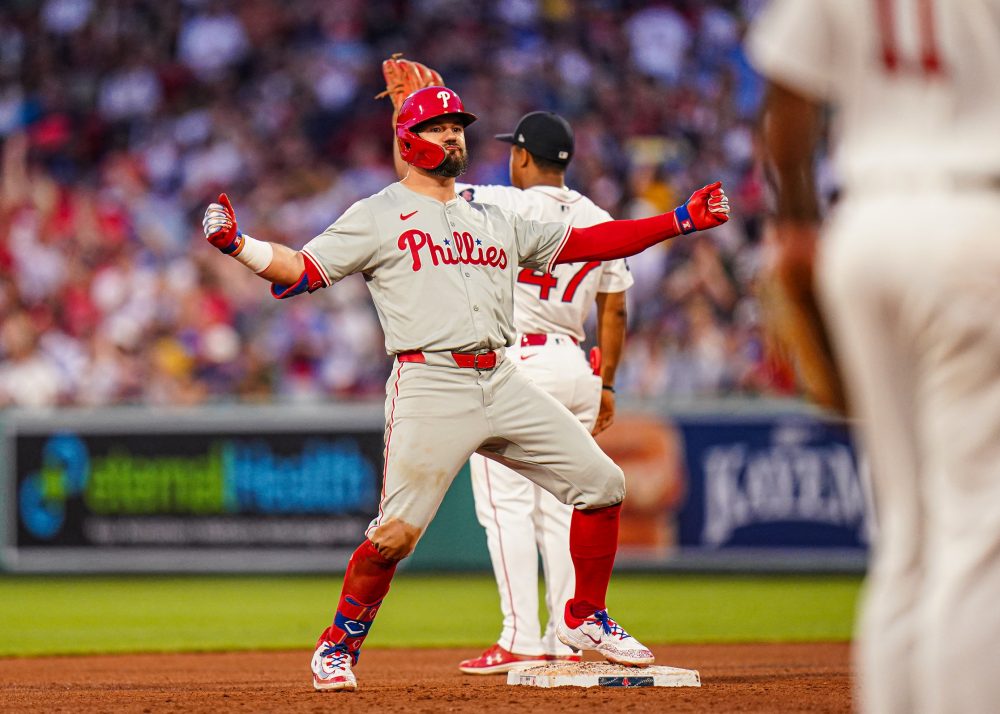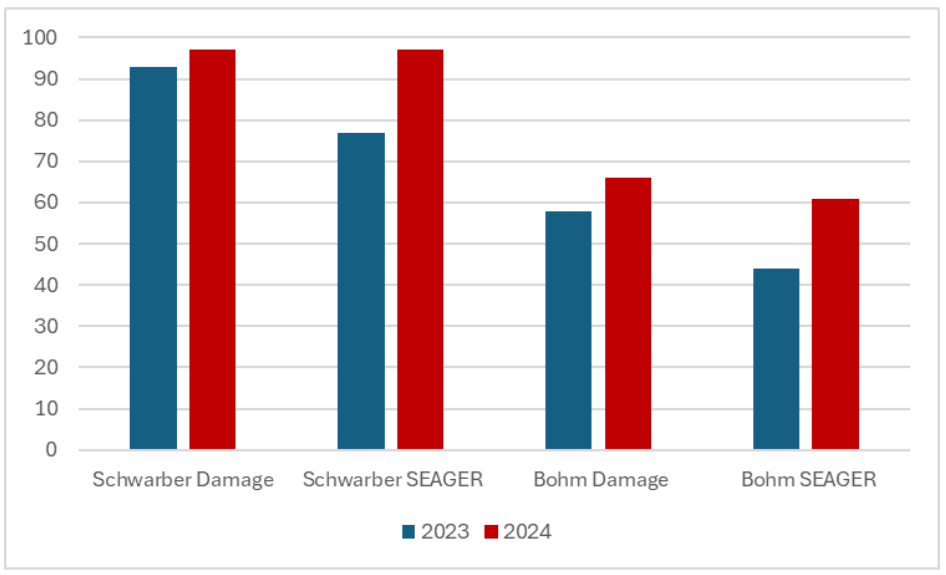
The Phillies had a modest start in this past Saturday’s game against Arizona. In the bottom half of the first, Kyle Schwarber came up to lead things off. He took a four-seamer from left-hander Tommy Henry up and in for a ball. When Henry went back to the well on the second pitch, he hit Schwarber. Trea Turner worked a few pitches and singled, and Bryce Harper did the same to knock in Schwarber. Alec Bohm popped out on the first pitch he saw. Nick Castellanos hit a lazy fly ball to right that was deep enough to drive in Turner, and then Bryson Stott struck out looking. It could’ve been a bigger inning, but a 2-0 lead was nothing to sneeze at.
It got more interesting in the third, when Schwarber came up again to start it off. He passed on a first pitch slider and fouled off an 0-1 changeup, a pitch Henry uses to great effect when ahead in the count. He got an 0-2 four-seamer that couldn’t quite stretch the zone and Schwarber laced it for a double to left-center field. Harper smashed a homer on a first pitch curveball—a pitch Henry hardly uses to start a plate appearance. Turner grounded out. Bohm worked a pair of four-seamers to a 1-1 count, spit on a changeup below the zone, and then whiffed on one that was more enticing. At 2-2, he got a fastball and drove a home run out to center field. Now 5-0, the Phillies had blown it open. Henry would earn another few batters but was worn out before getting through four innings.
| Pitch type | FA wOBA | SI wOBA | CH wOBA | CU wOBA | SL wOBA |
| Henry, ahead in count | .379 | .254 | .190 | .266 | .355 |
| Henry, behind | .627 | .650 | .527 | .432 | — (only two thrown) |
The work to make it happen started much earlier than the first pitch, in the midst of weather that had kept most every hitter on both teams inside. A heat wave had settled in for the better part of a week in Philadelphia, despite it only being supposed to last for a couple of days. With temperatures pushing 100, the city was boiling, and any time spent outside for more than a couple of minutes left you languishing as your body did its damndest to keep you cool with sweat but let you know exactly what its limits were. It didn’t stop Kyle Schwarber and Alec Bohm, though.
Shortly after noon, hours before the ballpark would open to fans, they took the field with a staffer. With them was a pitching machine that, from the pressbox, looks like a giant fidget spinner. The iPitch is designed to imitate the spin and arm slot of a pitcher, and is one of the machines the team has made a concerted effort to incorporate. Schwarber, whose performance against lefties this year has not gone unnoticed, settled in against it. Mimicking the weather, the exercise was slow but deliberate. He stood in the box and tracked a pitch, watching it go by. He measured one and took a cut, knocking a wobbler that didn’t inspire confidence. Then he repeated the process. He stepped out of the cage to rotate with Bohm, exchanging a few words. The third baseman’s cuts were more on the money sooner but still included mishits and only a few liners.
During the second round, Schwarber stood in the box and talked with the staffer operating the machine. He held his arm out and guided it the way someone does while explaining how they ended up at the wrong spot when driving in an unfamiliar area. He stepped back and leaned against the batting cage, just watching pitches come in. And then he stepped to the plate and smashed a fly ball to left-center field, and then did it again. Bohm came back in and made more solid contact sooner, before cracking a no-doubter that rang off the empty seats in the outfield.
Baseball is a game that invites you to believe in the delight of coincidence but this is an instance in which such acceptance would be misguided. After working through what they could see before the game, Schwarber and Bohm each worked through Henry’s better pitches during it, eventually driving ones that tilted the score in the Phillies’ favor. The final was a 12-1 rout. The team had a goal to be more exacting after being rubbed out of the NLCS by the Diamondbacks last October. The damage they could create on contact was never in question—they’ve ranked near the top of the league in doing that the last few years. But their ability to do it on a consistent basis was, because they ranked near the very bottom of the league in choosing which pitches to attack. They were always dangerous but always vulnerable.
When asked about it after the game, manager Rob Thomson said that “early work on the curveball machine” had become a routine for the club, “just to mimic the shape” of what a pitcher can throw. It was a plain statement but didn’t need to be more. For a club that had been undone in the past by its vibe-based, free-swinging nature, being able to have a feel for what could be coming down the pipe is a critical experience.

All stats in the above graph are by percentile. The improvements made by Schwarber and Bohm from last season to this one are impressive, especially when it comes to SEAGER. By raw numbers among hitters who are least average in choosing which pitches to attack, Schwarber’s leap is the 10th-best in the league. Bohm’s is 31st, and takes him from below average to comfortably above it. (Notably, Edmundo Sosa’s is the best, which goes a long way toward explaining how he filled in for Trea Turner as if he extracted Turner’s secret stuff a la Space Jam.)
As a team, the Phillies have gone from 27th in the league in SEAGER to 13th. It is the third-biggest improvement by rank that any team has made since 2023 and exactly the kind of performance necessary to level off the peaks and valleys they’ve faced in the last couple of years. By raw number, it’s less than a percentage point. That might seem insignificant but only a small handful of teams will improve by even a couple percentage points from one year to the next. What they have achieved so far in 2024 is notable, and underscores how the impact of just a couple of players can be so influential that a team can operate on a different plane.
As for how Thomson feels about the team’s hitting work, he remained plain. “It seems like it’s helped.”
Thank you for reading
This is a free article. If you enjoyed it, consider subscribing to Baseball Prospectus. Subscriptions support ongoing public baseball research and analysis in an increasingly proprietary environment.
Subscribe now